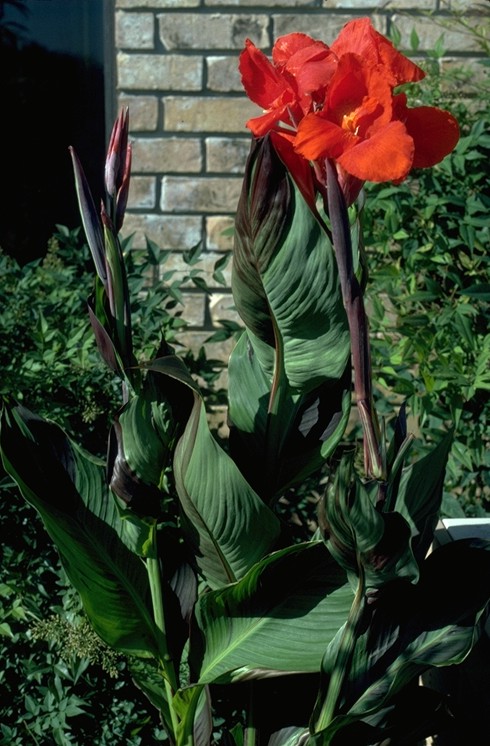Search
For The Answer
Click here to access our database of
Plant Answers
Search
For The Picture
Click here to access the Google database of plants
and insects
Milberger's Nursery and Landscaping
3920 North Loop 1604 E.
San Antonio, TX 78247
210.497.3760
nursery@milbergersa.com

Three exits east of 281, inside of 1604
Next to the Diamond Shamrock station
Please click map for more detailed map and driving directions.

You
Canna if You Wanna!

You Canna if You Wanna!
Greg Grant
Cannas are the Rodney Dangerfields of the Southern
garden. They don't get ANY respect! What amazes me however, is how
prized they are throughout the rest of the world. Gardeners in the
northern U.S. and Europe love their cannas, in spite of the fact that
they have to dig and store them every winter or grow them as annuals.
I know what the problem is. Cannas are too easy to grow. That's right.
Modern gardeners have been trained to turn their noses up at plants
that don't require tender love and care. After all, what kind of challenge
is it to grow plants that grow themselves year after year?
Cannas aren't the only downtrodden plant in this lowly group. Southern
gardeners are famous for having thrown out a number of our best plants
that are too easy to grow. That's what happened to China roses, pink
phlox, crinums, double orange daylilies, St. Joseph's lily, Grand
Primo narcissus, Byzantine gladiolus, Turk's cap, and numerous others.
Plants that grow themselves invariably end up on the wrong side of
town. And as soon as snooty gardeners see some easy to grow plant
in the ditch along the train tracks or growing in some crown tire
planter on the south side, they associate the plant with it's environment
and pan the plant as socially unacceptable.
It's an old elitist gardeners habit that frankly I'm tired of. First
of all, gardening belongs to everyone. We should be happy that there
are plants that everybody (including my horticulturally challenged
family) can grow. Also, the days of creating artificial environments
with chemicals and expensive labor are over. It's not environmentally
responsible nor is it an efficient use of a gardeners valuable time
to try to grow plants that don't want to grow.
Who cares where you saw a plant last? The important thing is to remember
those plants that you see in tough environments and use them artistically
in your own landscape.
Cannas are often maligned because they are too big, too bold, and
too brash. Doesn't that sound like a Texas plant to you? Plus, cannas
now come in heights from two feet to 10 feet, and in colors from the
palest creams to the brightest oranges.
Cannas are also bashed because of a little pest called the canna leaf
roller. He's the little larva of the skipper butterfly known for trick
shooting straight rows of holes into the leaves. Heck, if we threw
out every plant that had a pest problem we wouldn't be growing periwinkles,
hibiscus, tomatoes, roses, azaleas, passion vines, oak trees, fruits
trees, etc... I don't even use insecticide for canna leaf rollers.
Whenever the foliage looks ragged from insects or our habitually tough
climate, I just cut them to the ground, water and fertilize them,
and PRESTO, brand new plants and flowers in a matter of weeks. It
doesn't matter if you use a machete, string trimmer, brush cutter,
tractor, or a flame thrower. The amazing results are still the same.
My gardening friends from the North (yes I do have a few friends)
can't believe that we don't groom and dead-head our cannas in the
South. Meticulous gardeners pick the dead flowers and shot leaves
off as they occur. Many Southern gardeners won't even admit to owning
them, much less primping them!
In addition to their toughness, cannas are fabulous for their bold
foliage. I'm particularly partial to those with burgundy (OK, Aggie
maroon) foliage. These would be great southern landscape perennials
even if they had no flowers. But guess what? Bold canna foliage has
been bumped up a notch with the addition of the latest horticultural
gardening craze...variegated cannas. In addition to their green and
bronze foliaged brothers (and sisters), cannas now come in a range
of striped foliaged beauties. There's hardly a specialty catalog in
the country now that's not carrying at least one of these new striking
southern perennials. Give them a try. Cannas need love too!
Here's what's available:
'Bengal Tiger': One of the best cannas on earth! It also goes by the
name of 'Pretoria'. This medium sized canna with bright orange flowers
has green and cream striped foliage with a thin maroon line around
each leaf.
'Phaison': This spectacular beauty is sold under the tradmarked named
of Tropicanna TM. In my opinion, it has the most beautiful canna foliage
out of the nearly hundred cultivars I've grown. The leaves are a beautiful
combination of orange and burgundy. Even if it never produced it's
bright orange flowers, it would be worth growing. My mother uses the
leaves in her floral designs.
'Pink Sunburst': This is a semi-dwarf canna with pink flowers above
pink and green striped foliage.
'Durban': This medium to large cannas resembles Tropicana TM but had
larger leaves and red flowers.
'Nirvana': This older semi-dwarf canna has yellow flowers above green
and white striped foliage. It also goes by the name of ?Striped Beauty?.
I got mine from the late Mattie Rosprim, a mutual friend of mine,
Neil's, and Bill Welch's.
'Cleopatra': Another older variety with foliage that can be green,
burgundy or striped and can produce either red or yellow flowers or
some combination of both. It's quite a novelty. Tony Avent of Plant
Delights Nursery calls it the schizophrenic canna.
Sources:
Retail:
King's Nursery, Hwy. 84 East, Tenaha, Texas 75974. 409-248-3811.
Mail Order:
Plant Delights Nursery, Inc. 9241 Sauls Road, Raleigh, North Carolina
27603. 919-772-4794. Catalog price: 10 stamps of a box of chocolates.

